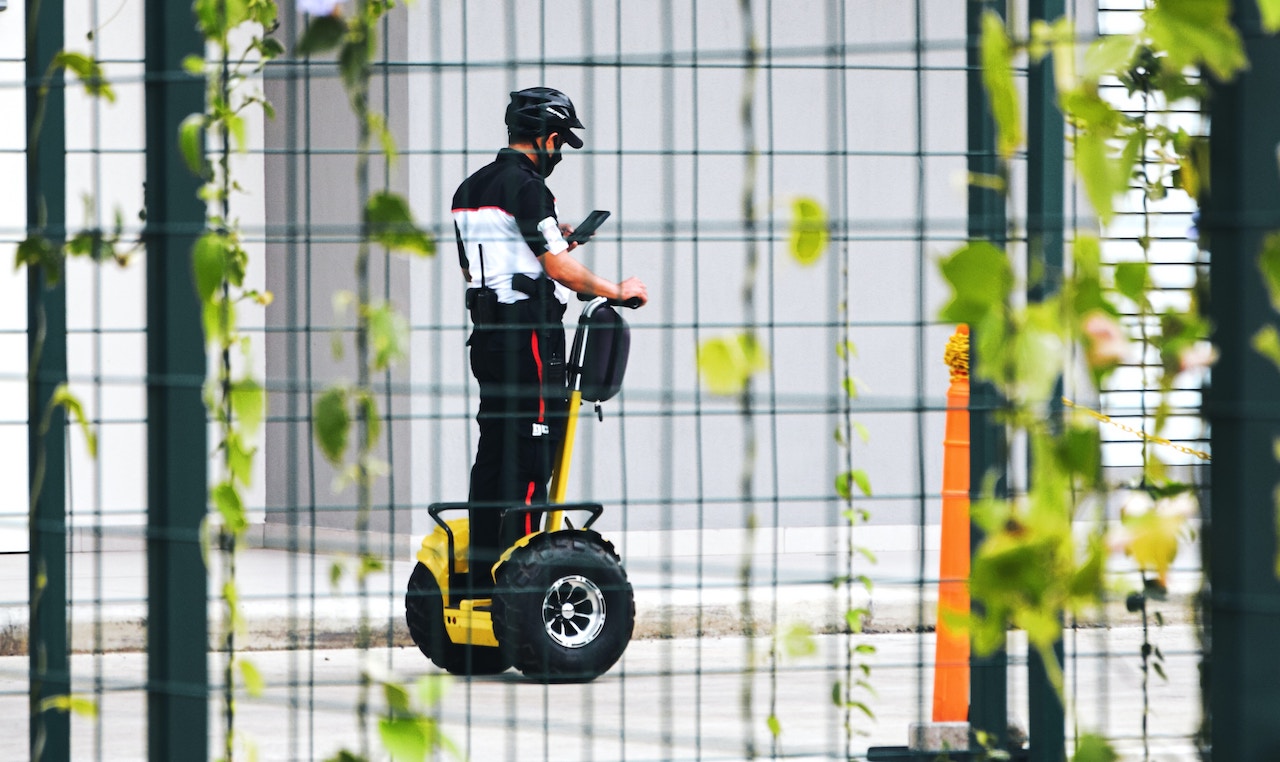Though the world grows more and more digital, physical security is still just as vital as cybersecurity. Locks, fences, security guards, and more are all just as important as anti-virus software. A solid understanding of physical security is just as paramount today as it was yesterday for security professionals. If you’re interested in becoming a security professional, read on to expand your knowledge about physical security and how to develop a physical security plan in the future.
What is Physical Security?
Physical security refers to the measures and practices put in place to protect physical assets, people, and information from unauthorized access, damage, theft, or harm. A wide variety of security methods are used to safeguard physical spaces, infrastructure, and resources. Physical security is an essential aspect of overall security management and is commonly employed in a wide range of environments, such as residential buildings, commercial offices, data centers, government facilities, airports, and more.
The Importance of Physical Security
Physical security is a critical layer of protection, complementing other security measures like cybersecurity. An effective physical security plan can help deter threats, minimize vulnerabilities, and enhance the safety and well-being of individuals and assets within a given environment.
For Work Environments
Physical security measures safeguard valuable assets, including equipment, data, inventory, and property, from theft, damage, or unauthorized access. This protection helps organizations preserve their investments and maintain operational continuity.
Many industries also have specific regulations and legal requirements related to physical security. Meeting these standards helps organizations avoid penalties, legal liabilities, and reputational damage.
Proper physical security measures also help maintain the flow of business operations and allow for continual productivity, thus ensuring businesses are able to turn a profit. Employees and customers are equally protected by physical security, increasing both customer and employee loyalty and trust in the business itself.
Learn more: Workplace Security 101: Policies, Procedures, and Examples
For Residential Spaces
Private and multi-family residences often implement physical security to keep residents safe from various threats. Physical security measures provide a safe environment for individuals and families by minimizing the risk of accidents, violence, or other harmful incidents. Residents are also able to trust that their valuables and other goods are safe within their property thanks to physical security measures.
For National Security
Government facilities employ physical security to maintain national security. Access control and visitor management measures are necessary to ensure the safety of citizens, armed forces, government officials, and more.
Key Elements of Physical Security
A wide variety of security measures are typically employed in physical security. Depending on the location being protected, a building’s security plan might include one or several of the following security measures.
Access Control
Perhaps the most fundamental physical security measure, access control involves regulating and monitoring who can enter specific buildings and areas using locks, access cards, biometric systems, and security personnel. Access control helps keep unwanted or unauthorized visitors from entering the building, mitigating security risks early on.
Learn more: What Does an Access Control Security Guard Do?
Visitor Management
Though partly covered by access control measures, visitor management goes beyond simply controlling where building guests are allowed to go. Visitor management involves implementing procedures to track and manage visitors' entry and exit, such as sign-in procedures and guest badges, as well as assigning escorts and limiting time spent within secure areas.
Surveillance Systems
Surveillance systems are incredibly important when it comes to physical security. Commercial and private buildings use video cameras, CCTV (Closed-Circuit Television) systems, and other monitoring devices to observe and record activities in and around the premises. The presence of surveillance cameras generally deters criminals or trespassers from attempting to enter areas where they’re not permitted.
Asset Protection
Asset protection involves employing measures like asset tracking, secure storage, and anti-theft devices to safeguard valuable equipment and resources. This may be done for merchandise sold in retail stores, for computer equipment used in office buildings, artifacts within a museum, and more.
Perimeter Security
Protecting the outer boundaries of a property or facility is often necessary, especially when the areas are dangerous, private, or classified. Perimeter security includes features like fences, walls, gates, and barriers to prevent unauthorized access. Prisons, government facilities, construction sites, and even private residences often feature perimeter security for safety and privacy.
Security Personnel
Security guards play a crucial role in enhancing physical security and provide several benefits to the overall safety and protection of an organization or premises. Security guards or personnel patrol and monitor the premises, respond to incidents, provide a visible deterrent to potential threats, and are responsible for maintaining and enforcing security measures.
Learn more: What a Security Guard Can and Cannot Do
Intrusion Detection Systems
When buildings or areas cannot be monitored at all times, intrusion detection systems help add an additional layer of security. Installing alarms and sensors to detect unauthorized access or breaches in secure areas can stop potential break-ins and breaches in security.
Environmental Controls
Criminals are not the only threat to security. Weather and other environmental factors can compromise security. Ensure the safety of physical assets by using temperature control, fire suppression systems, and other measures to mitigate environmental risks.
Emergency Planning and Response
Emergency preparedness is a vital aspect of physical security. An emergency can constitute anything from a natural disaster to an active shooter on the premises. To keep personnel and resources safe in the event of an emergency, develop and practice protocols for responding to emergencies, such as fire drills, evacuation procedures, and crisis management.
Learn more: Lockdown Procedures for the Workplace: Security Officer Guide
How to Create a Physical Security Plan
Creating a comprehensive physical security plan involves a systematic approach to identifying potential threats, vulnerabilities, and the implementation of appropriate measures to mitigate risks. Creating a physical security plan often involves the following steps
1. Conduct a risk assessment
Begin by conducting a thorough risk assessment of your premises or organization. Identify potential threats such as theft, vandalism, unauthorized access, natural disasters, etc., and assess the vulnerabilities and potential impact of each threat. This assessment will serve as the foundation of your physical security plan.
2. Set clear objectives
Define the specific objectives and goals of your physical security plan. These objectives should be aligned with the identified risks and vulnerabilities, as well as the overall security needs of your organization.
3. Determine the appropriate security measures
Based on the risk assessment and objectives, determine the security measures that need to be implemented. This may include access control systems, surveillance cameras, security personnel, intrusion detection systems, alarms, and environmental controls. Not every organization will have the same security measures implemented.
4. Implement the chosen security measures
Once you’ve chosen the appropriate security measures for the premises, begin implementing them accordingly. Create access control policies that regulate who can access different areas within your premises. If needed, use a combination of physical barriers, access cards, biometric systems, and visitor management procedures to control access effectively.
Install surveillance cameras strategically to monitor critical areas and potential points of entry. Consider using CCTV systems with recording capabilities for later review and investigation.
If necessary, hire trained security personnel to patrol and monitor your premises. Ensure they are well-trained in security procedures, emergency response, threat detection, and more.
5. Establish emergency response protocols
Regardless of the premise’s physical security needs, you should develop a clear and comprehensive emergency response plan. Include protocols for various scenarios, such as fire, medical emergencies, natural disasters, or security incidents. Conduct regular drills to ensure your security personnel or staff are familiar with the procedures.
6. Test the plan
Conduct tests and simulations to evaluate the effectiveness of your physical security plan. Use this information to fine-tune your security measures and improve overall preparedness.
7. Document the plan
Document your physical security plan in a comprehensive and accessible manner. Include all policies, procedures, contact information, and emergency response protocols in the documentation. Share the plan with staff, faculty, and other stakeholders.
8. Involve stakeholders
Involve all relevant stakeholders, including employees, management, and local law enforcement, in the planning process. Communicate the security plan and ensure everyone understands their roles and responsibilities in the event of an emergency or security breach.
9. Regular reviews and updates
Security threats and the organizational environment can change over time. Schedule regular reviews of your physical security plan to identify any gaps or necessary updates and make adjustments as needed.
Start Your Career in Physical Security
Interested in becoming a security professional and building a physical security plan of your own? Start your journey with NITA. We have hundreds of online training courses for aspiring security professionals that are completely online and on demand. Prepare for your licensing exam on your own time and continue your education with professional development courses whenever you need them. NITA is here to support your career as a security professional.
View Security Guard Courses from NITA →
You might also like:
Our enrollment counselors are here to answer any questions you might have about our state- and board-approved status, pre-licensing training, or professional development programs.




